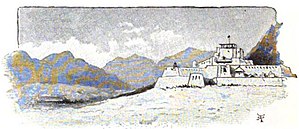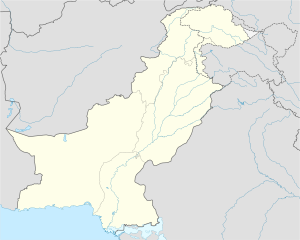| Revision as of 15:18, 25 January 2023 editJaverine (talk | contribs)Extended confirmed users886 edits →Prelude and battle: updated as mentioned on the page← Previous edit | Revision as of 15:59, 25 January 2023 edit undoJaverine (talk | contribs)Extended confirmed users886 editsm →Prelude and battleNext edit → | ||
| Line 37: | Line 37: | ||
| ==Prelude and battle== | ==Prelude and battle== | ||
| Towards the end of 1836, Sardar ] attacked and captured the small, but very strategic, fortified Khyberi village of ], situated on the south-side of a range of mountains at the mouth of the ]. With the conquest of ], the frontier of the Sikh Empire now bordered the frontier of Afghanistan.<ref name="Vanit1" /> | Towards the end of 1836, Sardar ] attacked and captured the small, but very strategic, fortified Khyberi village of ], situated on the south-side of a range of mountains at the mouth of the ]. With the conquest of ], the frontier of the Sikh Empire now bordered the frontier of Afghanistan.<ref name="Vanit1" /> | ||
| In 1837, the ] was in ] for the wedding of ], the grandson of ] ]. The Emir of Afghanistan, ], sent his sons with an army to drive the Sikhs out of ]. The Sikh general, Sardar ] was mortally injured in the battle and later died after forcing his way into the fort. According to Afghan chronicle Siraj |
In 1837, the ] was in ] for the wedding of ], the grandson of ] ]. The Emir of Afghanistan, ], sent his sons with an army to drive the Sikhs out of ]. The Sikh general, Sardar ] was mortally injured in the battle and later died after forcing his way into the fort. According to Afghan chronicle Siraj al-Tawarikh, Akbar Khan and Hari Singh Nawla engaged in a duel without recognizing each other. After much thrusting and parrying, Akbar Khan won out and Hari Singh Nawla was knocked to the ground and killed.{{sfn|Dalrymple|2012|p=89}} Many eyewitnesses claimed Nalwa ordered his dead body to be hung outside the fort before he died, discouraging the Afghans from attacking, believing Nalwa was still alive.<ref name="punjab" /> Nevertheless, the Sikh garrison continued fighting until Sikh reinforcements arrived from Lahore and broke the Afghan siege. The battle ended when the Afghans retreated back to ].<ref name="Lafont1" /><ref name="Vanit1" /> | ||
| ==Result of the battle== | ==Result of the battle== | ||
Revision as of 15:59, 25 January 2023
1837 battle of the Afghan–Sikh Wars| Battle of Jamrud | |||||||
|---|---|---|---|---|---|---|---|
| Part of the Afghan-Sikh wars | |||||||
 A portrait of the Jamrud Fort | |||||||
| |||||||
| Belligerents | |||||||
|
|
| ||||||
| Commanders and leaders | |||||||
|
Akbar Khan Afzal Khan Mirza Sami Khan Josiah Harlan |
Hari Singh Nalwa † Mahan Singh Mirpuri Mangal Singh Ramgarhia Tej Singh | ||||||
| Strength | |||||||
|
7,000 cavalry 2,000 matchlockmen 20,000 Khybers 50 pieces artillery |
800 Jamrud garrison 10,000 relief force/reinforcements | ||||||
 | |||||||
The Battle of Jamrud was fought between the Emirate of Afghanistan and the Sikh Empire on 30 April 1837. Afghan forces confronted the Sikh forces at Jamrud. The garrisoned army was able to hold off the Afghans till Sikh reinforcements arrived to relieve them.
Background
The Battle of Jamrud was fought between the Sikhs under Maharaja Ranjit Singh and the Afghans under Emir Dost Muhammad Khan. Following the consolidation of the Sikh Empire in Punjab, Maharaja Ranjit Singh had begun a wave of invasions on Afghan-held territories. The Afghans had been losing their long-held territories to Sikhs over the preceding years, and had seen their once mighty empire shrink with the loss of the Punjab region, Multan, Kashmir, Derajat, Hazara, Balakot, Attock, Peshawar, and Jamrud.
Prelude and battle
Towards the end of 1836, Sardar Hari Singh Nalwa attacked and captured the small, but very strategic, fortified Khyberi village of Jamrud, situated on the south-side of a range of mountains at the mouth of the Khyber Pass. With the conquest of Jamrud, the frontier of the Sikh Empire now bordered the frontier of Afghanistan. In 1837, the Sikh Army was in Lahore for the wedding of Kanwar Nau Nihal Singh, the grandson of Maharaja Ranjit Singh. The Emir of Afghanistan, Dost Mohammad Khan, sent his sons with an army to drive the Sikhs out of Peshawar. The Sikh general, Sardar Hari Singh Nalwa was mortally injured in the battle and later died after forcing his way into the fort. According to Afghan chronicle Siraj al-Tawarikh, Akbar Khan and Hari Singh Nawla engaged in a duel without recognizing each other. After much thrusting and parrying, Akbar Khan won out and Hari Singh Nawla was knocked to the ground and killed. Many eyewitnesses claimed Nalwa ordered his dead body to be hung outside the fort before he died, discouraging the Afghans from attacking, believing Nalwa was still alive. Nevertheless, the Sikh garrison continued fighting until Sikh reinforcements arrived from Lahore and broke the Afghan siege. The battle ended when the Afghans retreated back to Kabul.
Result of the battle
The result of the battle is disputed amongst historians. Some contend the failure of the Afghans to take the fort and the city of Peshawar or town of Jamrud as a victory for the Sikhs. On the other hand, some state that the killing of Hari Singh Nalwa resulted in an Afghan victory. James Norris, Professor of Political Science at Texas A&M International University, states that the battle's outcome was inconclusive.
See also
References
- ^ Maharaja Ranjit Singh: A short life sketch, Ganda Singh, Maharaja Ranjit Singh: First Death Centenary Memorial, (Nirmal Publishers, 1986), 43.
- Jean Marie Lafont (2002). Maharaja Ranjit Singh. Atlantic Publishers & Distri. p. 43.
- Tom Lansford (2017). Afghanistan at War: From the 18th-Century Durrani Dynasty to the 21st Century. p. 21,22. ISBN 9781598847604.
In 1837, Afghan ruler Dost Mohammed Khan gathered an army to push the Sikhs back from the Khyber pass. They laid siege to the Sikh fort at Jamrud. A Sikh army advanced to relieve the siege, and the two forces met at the Battle of Jamrud. The Sikhs defeated the Afghans. The battle marked the end of the Afghan-Sikh wars.
- Dalrymple, William (2012). Return of a King: The Battle For Afghanistan (Paperback ed.). United Kingdom: Bloomsbury. ISBN 9780307948533.
- ^ Jean Marie Lafont (2002). Maharaja Ranjit Singh. p. 43.
In spite of all their efforts, however, the Afghans could neither occupy the fort of Jamrud nor dislodge the Sikhs from their position and gain possession of Peshawar.
- ^ Nalwa, Vanit (2009), Hari Singh Nalwa, "champion of the Khalsaji" (1791-1837), Manohar, p. 177-317, ISBN 9788173047855
- Dalrymple 2012, p. 89.
- Chief and families of Note in Punjab, Vol II, op.cit., pp. 87,89,90
- Several scholars consider the Sikhs to have been victorious: * Hasrat, Bikrama Jit (1977), Life and Times of Ranjit Singh: A Saga of Benevolent Despotism, V.V. Research Institute Book Agency, p. 137: "The doubtful Sikh victory at Jamrud in 1837 had made it clear to Ranjit Singh that policies of hatred and repression in the northwestern frontier so far pursued had failed in its objective." * Paddy, Docherty (31 July 2010), Khyber pass, Il Saggiatore, pp. 186–187, ISBN 978-88-6576-029-1 * Ingram, Edward (1993), "India and the North-West Frontier: The First Afghan War", in A. Hamish Ion; Elizabeth Jane Errington (eds.), Great Powers and Little Wars: The Limits of Power, Greenwood Publishing Group, p. 44, ISBN 978-0-275-93965-6: "The second was Peshawar, which controlled the entry to the Khyber Pass and had been seized in 1834 by Ranjit Singh from Dost Mohammed, who tried in 1837 to get it back but lost his chance at the Battle of Jamrud."
- Other scholars consider the Afghans to have been victorious: * Roberts, Jeffery J. (2003), The Origins of Conflict in Afghanistan, Greenwood Publishing Group, p. 4, ISBN 978-0-275-97878-5: "In 1837 Dost's son, Akbar Khan, led an Afghan army to victory at Jamrud. Akbar, however, did not follow up his success with an advance to Peshawar, and the city remained in Sikh hands." * Clements, Frank; Adamec, Ludwig W. (2003), Conflict in Afghanistan: A Historical Encyclopedia, ABC-CLIO, p. 74, ISBN 978-1-85109-402-8: "Dost Mohammed Khan defeated the Sikhs at the Battle of Jamrud in 1837."
- John, Norris; Norris, J. A. (1967), The First Afghan War 1838-1842, Cambridge University Press, p. 109, ISBN 978-0-521-05838-4: "The resulting Battle of Jamrud on 30 April 1837 was a bloody Sikh-Afghan encounter where both sides suffered severe losses. The outcome was largely inconclusive but served to further inflame the continued cross-border feuding and induced the Afghans to seek assistance from the Russian-influenced Persians."
| Pashtun-related topics | |||||
|---|---|---|---|---|---|
| Dynasties | |||||
| Key figures |
| ||||
| Culture | |||||
| Poets | |||||
| Groups |
| ||||
| Topics and controversies | |||||
| Battles and conflicts |
| ||||